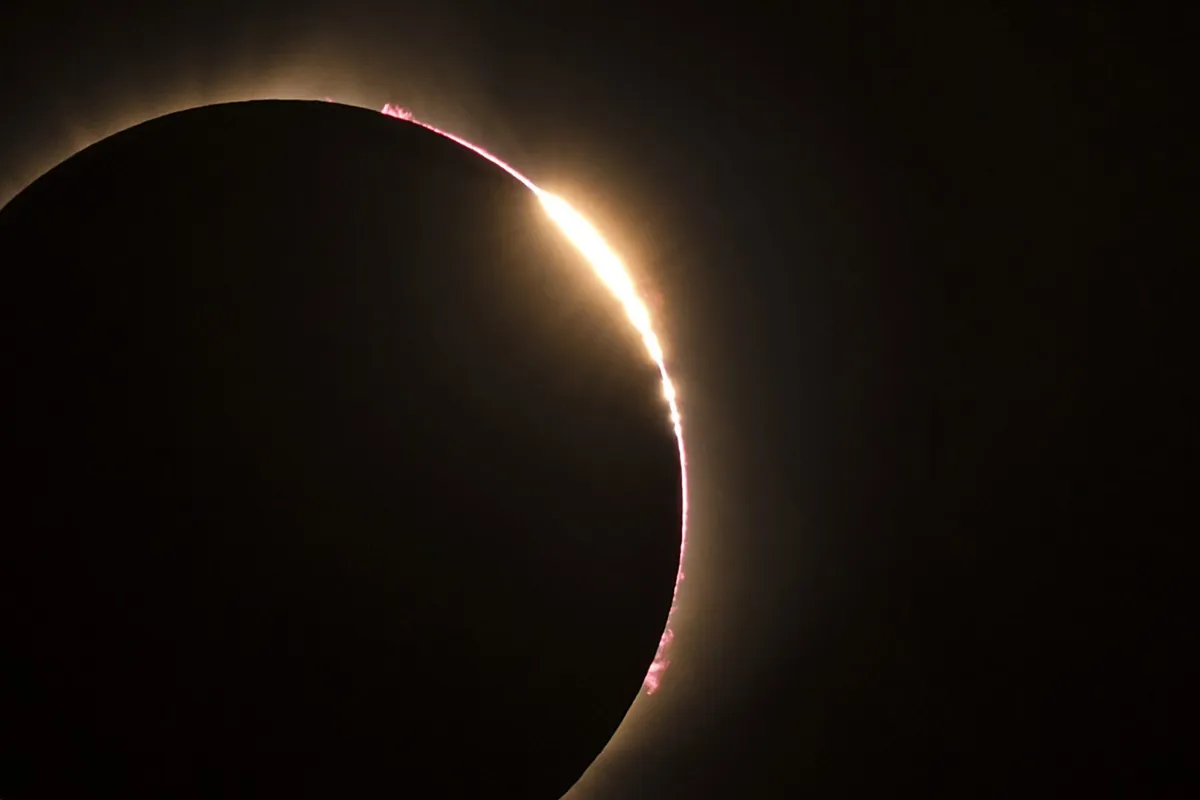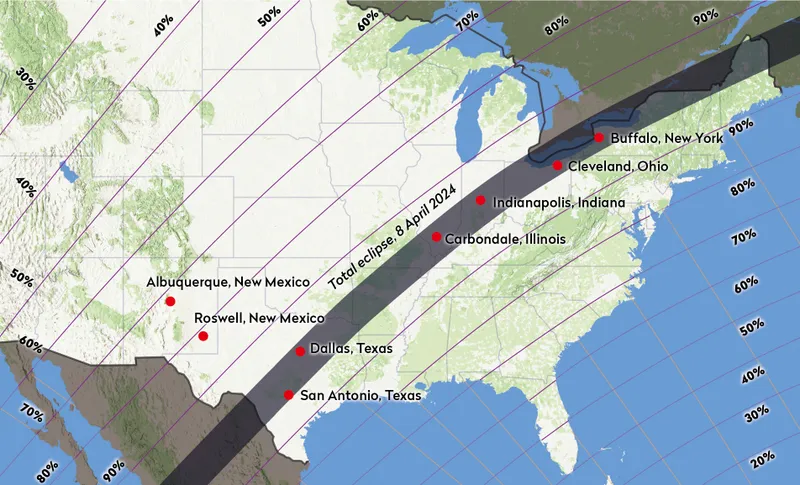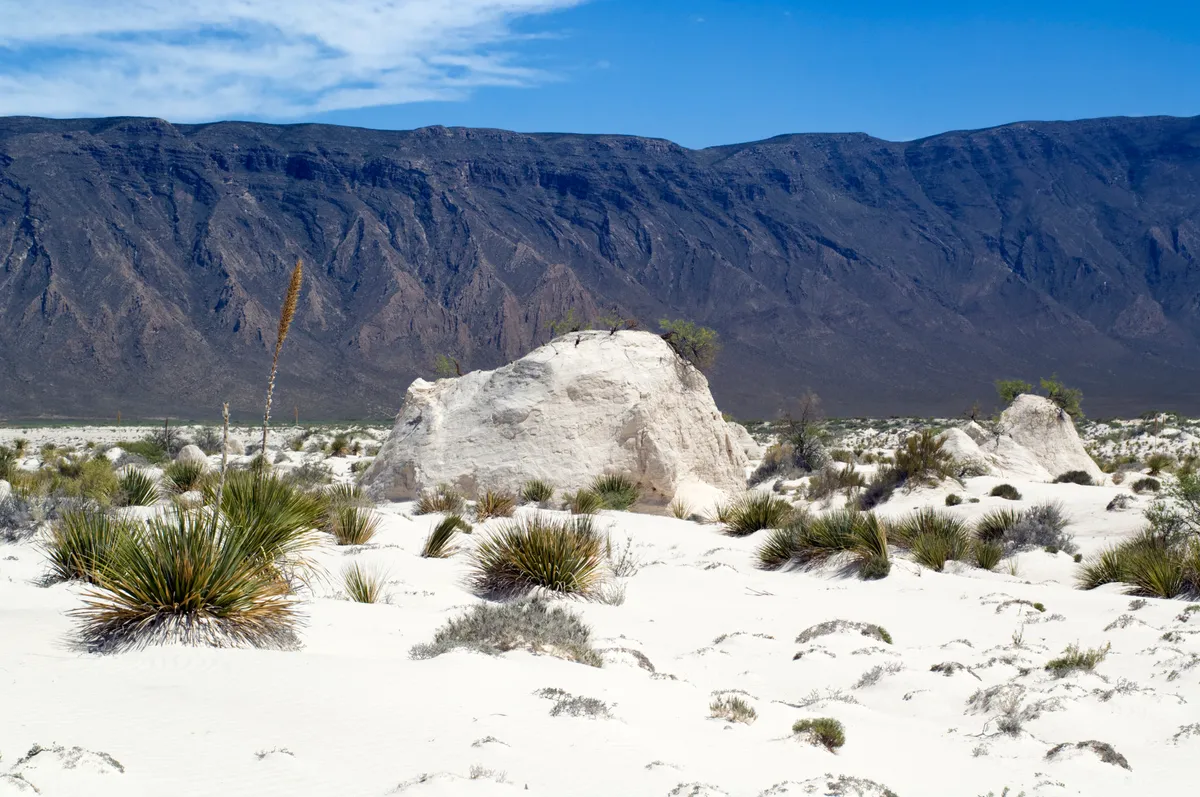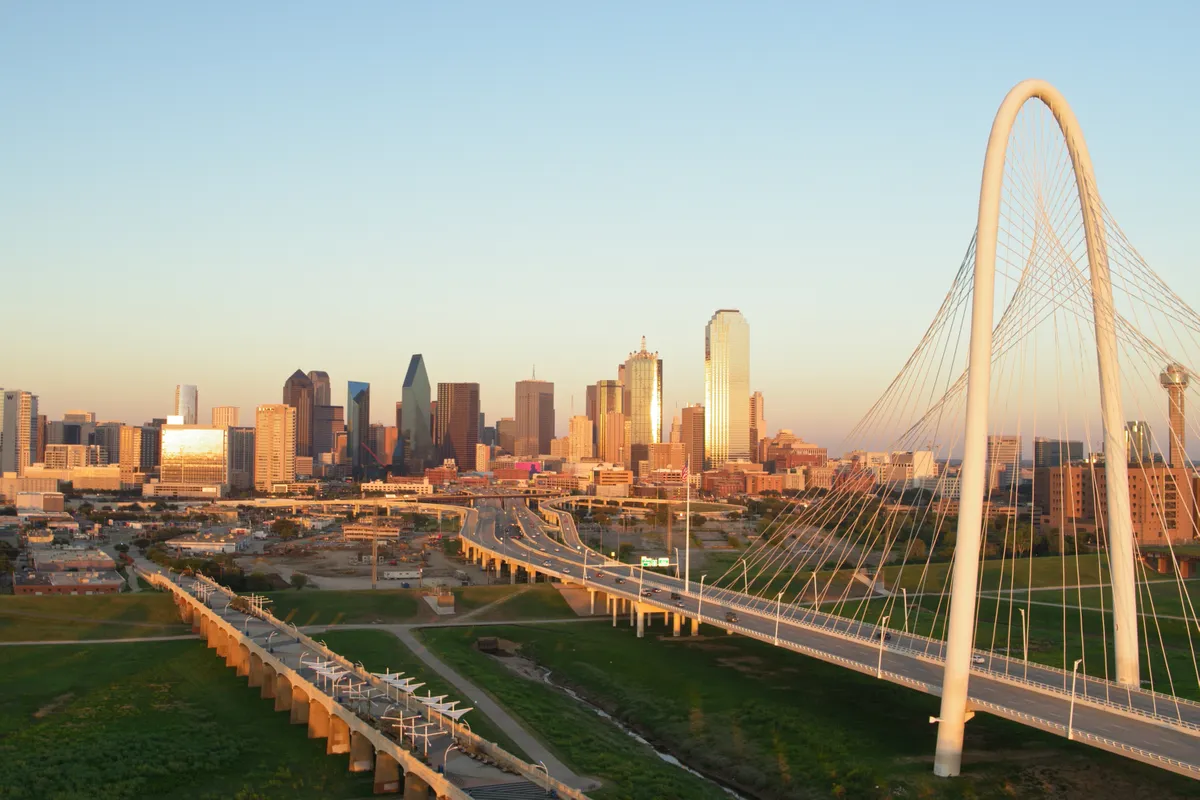The April 8 total solar eclipse that's coming to North America on Monday afternoon is one of the biggest astronomical events this year.
Beginning in Mexico and passing across the US and Atlantic Canada, it’s estimated that 32 million people live inside the path of totality for the 2024 April solar eclipse.
That’s 20 million more than in 2017 during the last total solar eclipse in the US, which went coast to coast.
This time it’s also much longer, with totality peaking at 4 minutes and 27 seconds. It comes less than six months after the October 14 ‘ring of fire’ annular solar eclipse in the US, Central and South America.
If you've viewing the solar eclipse this Monday, here's all you need to know, including what you'll see from your location, which areas will see totality and weather and cloud cover predictions.
April 8 solar eclipse explained

A total solar eclipse occurs when the Moon crosses in front of the Sun and its apparent size in the sky is just enough to completely cover the Sun’s disk, making it possible to glimpse the solar corona around the Moon’s silhouette for a few minutes.
This is called totality, during which the sky turns a deep twilight.
On either side of totality, it’s possible to see phenomena such as Baily’s beads and diamond rings as the last and first drops of sunlight are visible.
Total solar eclipses occur because of a coincidence of nature - our Sun is about 400 times larger than the Moon and also 400 times more distant from the Earth.
We may be the only planet in the Galaxy to experience total solar eclipses!
April 8 eclipse dates and times

The path of totality for the April 8 2024 total solar eclipse will be around 120 miles/190 kilometres wide.
Places from where the April 8 solar eclipse will be visible include:
Mexico
- Sinaloa
- Durango
- Coahuila
USA
- Texas
- Oklahoma
- Arkansas
- Missouri
- Illinois
- Kentucky
- Tennessee
- Michigan
- Indiana
- Ohio
- Pennsylvania
- New York
- Vermont
- New Hampshire
- Maine
Canada
- Ontario
- Quebec
- New Brunswick
- Prince Edward Island
- Newfoundland
Parts of the Texas Hill Country that will experience totality on April 8 2024 will have seen the ‘ring of fire’ annular solar eclipse on October 14 2023.

Observing totality
The closer you stand to the centre of the path of totality during a total solar eclipse, the longer the duration of totality
But you also have to think about weather.
The further southwest you are the better chance for clear skies.
Mexico, which will see its first total solar eclipse since July 11, 1991, is where the chances of a clear sky are highest.
Totality for the April 8 solar eclipse will be seen first in Mazatlán on the Pacific coast (4 min 17 sec, 11:09 am MST).
The Moon’s central shadow will leave the planet at South Bird Island, Newfoundland (2 min 53 sec, 5:13 pm NDT) in Canada.
You can find out more in our guide to April 8 eclipse weather and cloud cover.
Iconic sites where a total solar eclipse will be visible include:
- Stonehenge II, Ingram, Texas (4 min 25 sec, 1:31 pm CDT)
- Indianapolis Motor Speedway, Indianapolis, Indiana (3 min 40 sec, 3:06 pm EDT)
- Niagara Falls State Park, Ontario, Canada/New York, US (3 min 29 sec, 3:18 pm EDT)
- Mont Mégantic Observatory, Sherbrooke, Quebec, Canada (3 min 28 sec, 3:28 pm EDT)

National Parks, State Parks and Biosphere Reserves in the path of totality include:
- Cuatro Ciénegas Biosphere Reserve, Coahuila, Mexico (4 min 8 sec, 12:21 pm CST)
- Enchanted Rock State Natural Area, Texas, US (4 min 25 sec, 1:33 pm CDT)
- Crater of Diamonds State Park, Arkansas, US (3 min 37 sec, 1:47 pm CDT)
- Pinnacle Mountain State Park, Little Rock, Arkansas, US (3 min 23 sec, 1:50 pm CDT)
- Point Pelee National Park Dark Sky Preserve, Ontario, Canada (2 min 57 sec, 3:13 pm EDT)
- Presque Isle State Park, Erie, Pennsylvania (3 min 45 sec, 3:16 pm EDT)
- Kouchibouguac National Park Dark Sky Preserve, New Brunswick, Canada (3 min 16 sec, 4:34 pm ADT)

Major cities that will see the full April 8 eclipse (totality):
- Mazatlán, Sinaloa, Mexico (4 min 17 sec, 11:09 am MST)
- Durango City, Durango, Mexico (3 min 47 sec at 12:12 pm CST)
- Torreón, Coahuila, Mexico (4 min 11 sec at 12:16 pm CST)
- Dallas, Texas, US (3 min 49 sec from 1:40 pm CDT)
- Little Rock, Arkansas, US (2 min 30 sec from 1:51 pm CDT)
- Indianapolis, Indiana, US (3 min 47 sec from 3:06 pm EDT)
- Cleveland, Ohio, US (3 min 50 sec from 3:13 pm EDT
- Buffalo, New York, US (3 min 45 sec from 3:18 pm EDT)
- (Southern) Montréal, Québec, Canada (1 min 59 sec from 3:26 pm EDT)

How to observe an eclipse safely
Never look directly at the Sun without eye protection in the form of eclipse glasses and solar filters.
The long phases of a solar eclipse before and after totality cannot be viewed with the naked eye.
Everyone observing the April eclipse will need to wear eclipse glasses or use solar filters.
For more info, read the American Astronomical Association's guide on how to make sure your eclipse glasses are safe.

For those outside the path of totality, eclipse glasses will be required for the entire event.
For those inside the path of totality, for a few minutes during totality it is theoretically safe to observe with the naked eye.
But it’s preceded and followed by a partial solar eclipse that requires eclipse glasses, so observe with caution.
As with any solar observing, if you're not sure what you're doing, don't attempt it!
Alternative viewing methods

A safer way is to observe the eclipse indirectly, by making a solar projection screen.
The same safety warnings apply to cameras and binoculars, which should be used only with solar filters during the partial phases.
You’ll need to remove the solar filters during totality if you want to capture the corona on camera.
Keep an eye on the time so you know when the Sun is about to remerge – it’s important to replace your filters before then if you don’t want to damage your camera.
You could also observe the April 8 eclipse close-up by using a solar telescope.
And there's the classic colander method of observing an eclipse.
For more advice on this and other kid-friendly methods, read guide on how to safely view an eclipse.

Watch the April 8 total solar eclipse online
Not going to be in the US, or outside the path of totality? It will be possible to watch the April 8 2024 eclipse online from anywhere worldwide.
Timeanddate.com is hosting a livestream on YouTube, and NASA and San Francisco science museum Exploratorium are hosting the event too.
You can find embedded livestreams of all three below:
When is the next total solar eclipse?
The following total solar eclipse will occur on 12 August 2026 across Greenland, Iceland and northern Spain.
For more info, read our guide to find out when the next eclipse is happening.
Are you travelling to see the eclipse? Or are you based in the US and hosting an eclipse event? Let us know by emailing contactus@skyatnightmagazine.com.
